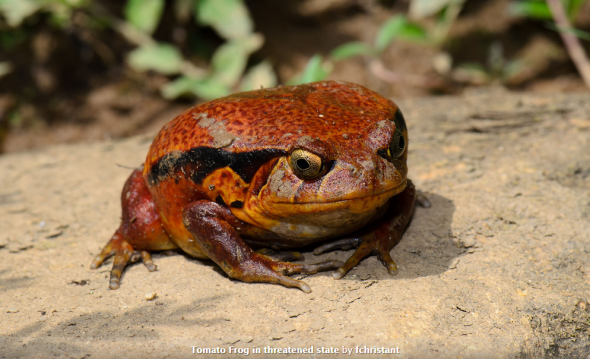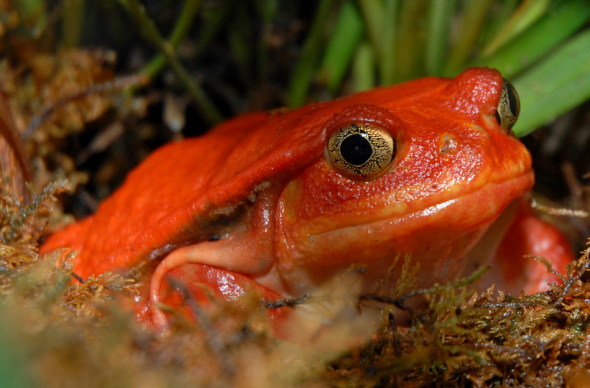Endangered Species Friday: Dyscophus antongilii
Endangered Species Friday: Dyscophus antongilii
This Friday’s endangered species article I focus on yet another Africans frog that is listing near endangerment. In fact this frog species is so threatened should conservation actions not improve we’re likely to see extinctions occur within the next decade. (Please note: the image above depicts the frog in threatened state - colors do differ)
Commonly known as the Tomato frog the species is one of three within the genus Dysophus. Scientifically identified as Dyscophus antongilii this particular genus is the only genus known to be at threatened status while the other two sub species are in fact listed as least concern.
Identified back in 1877 by Explorer Alfred Grandidier (20 December 1836 – 13 September 1921). Explorer Grandidier was a French naturalist and explorer. From a very wealthy family, at the age of 20, he and his brother, Ernest Grandidier (1833–1912), undertook a voyage around the world. At first they were led by the astronomer and physicist Pierre Jules César Janssen (1824–1907), but when Janssen fell sick and had to return to France after about six months, the brothers continued the journey.
They visited South America in 1858 and 1859 and in particular the Andes, Peru, Chile, Bolivia, Argentina and Brazil. During this voyage they gathered a significant collection of specimens which were analyzed, in 1860, by Ernest.
Conservation actions did improve the species back in the late 1990’s of which the D. antongilii was then listed as vulnerable. Since this time though conservation actions have improved to some degree leading to the species to then be re-listed back in 2002 as (near threatened). Unfortunately due to this particular genus being only native to the Africans island of Madagascar where habitat fragmentation, destruction, urbanization, species/human displacement, slash and burn operations are increasing only reduces frog habitat furthermore. Main causes of declines though are trade and pollution of water bodies.
D. antongilii is known to be abundant, however populations of this particular genus are currently unknown on the island. Locals have stated D. antongilii is most commonly seen within the Maroansetra region on the island of Madagascar. Unfortunately when environmentalists undertook surveys and census counts within the area with regards to the locals knowledge of the species, it was found that populations are actually declining quite rapidly. One such problem that has been noted by International Animal Rescue Foundation Africa was the increasing tropical pet trade.
International Animal Rescue Foundation Africa and International Animal Rescue Foundation England located a broad range of pet suppliers within England and America. Despite D. antongilii classified as “near threatened” and in overall decline one can purchase this exact genus within the United States for as little as $29.99. Meanwhile within the counties of Manchester, Nottingham, London, Kent and Wales pet suppliers were trading for around £30.99.
On researching a pet supplier within the United States not only did we locate evidence of D. antongili on sale, other species of threatened and “endangered” animals were also on sale. A search of their Facebook social media page also aroused suspicions of which they have since closed down. Pet Solutions, Beavercreek based in Ohio can be located here: http://www.petsolutions.com/C/Live-Frogs/I/Tomato-Frog.aspx meanwhile their Twitter account can be viewed hereto: https://twitter.com/petsolutions
Image: Tomato frog in normal relaxed mode shows their unique tomato coloring.
The species lives in primary rain-forest, coastal forest, secondary vegetation, degraded scrub, and highly disturbed urban areas. It is a very adaptable species, but possible declines in Maroansetra indicate that there might be a limit to the extent that it can persist in urbanized habitats. It appears to be localized to sandy ground near the coast, and breeds in ditches, flooded areas, swamps, and temporary and permanent still or very slowly flowing water.
Tomato frogs breed in February to March following heavy rainfall; the sounds of males calling to attract females can be heard around small water bodies in the dark Malagasy night. Following copulation, females will lay a clutch of 1,000 to 15,000 eggs on the surface of the water. Tadpoles hatch from these small black and white eggs about 36 hours later; they are only around six millimetres long and feed by filter-feeding. Tadpoles undergo metamorphosis into yellow juveniles and this stage is completed around 45 days after the eggs were laid.
Ambushing potential prey, adult tomato frogs feed on small invertebrates, such as beetles, mosquitoes, and flies. When threatened, these frogs can inflate themselves, giving the appearance of greater size.
Threats
Pollution of water-bodies is a potential threat, and in the past this species was subject to collection for international trade, although this is now largely under control and restricted. Despite trade allegedly being restricted - it seems this is not the case as International Animal Rescue Foundation Africa have located over 34 suppliers in the last week, many of which have ties back to Asia and Africa. International trade is indeed taking off again, and with a population in decline - international trade must cease immediately.
This colorful species is much in demand by herpetological hobbyists. Captive breeding, in addition to CITES listing, has effectively halted the trade in wild-caught specimens. However it must be noted that captive breeding cannot always be proven within the private industry, and scrutiny must always be used to conclude if any breeder is following the relevant procedures and laws in place.
Research into captive breeding techniques for the tomato frog has been carried out by Baltimore Zoo in the United States in an effort to boost the currently small and genetically deprived captive population that exists in that country.
A consortium of U.S. zoos that form the Madagascar Fauna Group (MFG) have established an exhibit at the Parc Zoologique Ivoloina, Madagascar in an attempt to help educate local people about this attractive member of their natural heritage. Very little is known about the tomato frog and further research into its distribution, behavior and potential threats is urgently needed before effective conservation measures can be put into place.
It is currently listed on Appendix I of the Convention on International Trade in Endangered Species (CITES), but this move has been criticized by some authors as an ineffective strategy and one that has undermined the status of the unlisted D. guineti. Furthermore, research is needed to determine if D. antongilii is in fact a separate species or merely a variant of D. guineti.
Thank you for reading and taking the time to educate yourself and others about this amazing reptile.
Dr Jose C. Depre
Chief Environmental Officer/ CEO
Botanical and Environmental Scientist.





